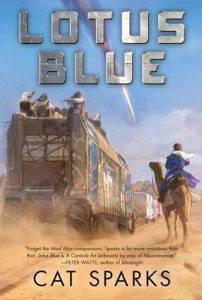 It is an absolute thrill to be able to share the news that my PhD thesis, (short title) “Watermarks”, has been awarded the Aurealis Awards Convenors’ Award for Excellence.
It is an absolute thrill to be able to share the news that my PhD thesis, (short title) “Watermarks”, has been awarded the Aurealis Awards Convenors’ Award for Excellence.
The award, to quote the Aurealis website:
is awarded at the discretion of the convenors for a particular achievement in speculative fiction or related areas in that year that cannot otherwise by judged for the Aurealis Awards.
This award can be given to a work of non-fiction, artwork, film, television, electronic or multimedia work, or one that brings credit or attention to the speculative fiction genres.
To be more accurate, I guess, it was the exegesis that received the award, as the creative component was not included; the judges considered the non-fiction element of the thesis only.
The thesis, minus the creative component, is available to read at Academica.edu. In short, again borrowing from the AA website, the thesis
examines the benefits of the application of science fiction approaches and tropes to climate fiction with the aim of breaking down barriers to understanding climate change and adopting mitigation measures. In particular, it looks at mosaic fiction, and examines three Australian texts – Things We Didn’t See Coming (Amsterdam), Clade (Bradley) and Nightsiders (Isle) – as case studies that draw on the mosaic form and SF to create affective and effective climate fiction
Unfortunately, I had already made plans for the night of the awards (25 July 2020) when the date was announced, and it never occurred to me to send in an acceptance speech on the off-chance. My apologies, and gratitude, again to the hardworking crew who make these awards happen. And heartfelt thanks to my supervisors at The University of Queensland for their brilliant support, my wife for putting up with a PhD student in the house, and all those others who helped ferry me along the journey. The award is a lovely postscript to a challenging and rewarding endeavour.
I’ve been to so many Aurealis Awards nights because they are such a great opportunity to celebrate the achievements of Australian speculative fiction, and just catch up; I’m especially bummed to have not been (tele)present at the one ceremony where I actually won something!
Do check out the full list of finalists to get an idea of what’s happening in the field; it’s a great reading list.












